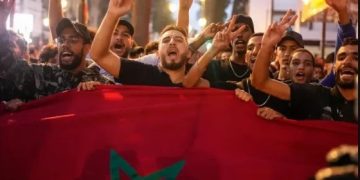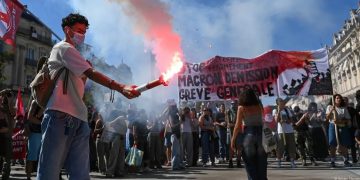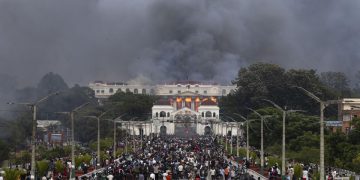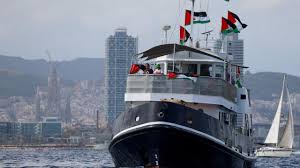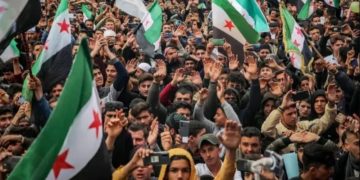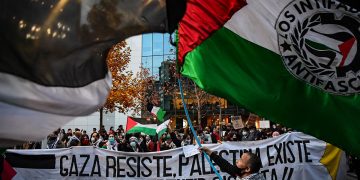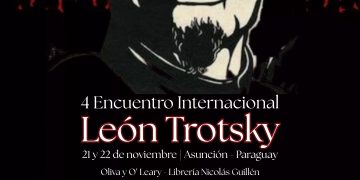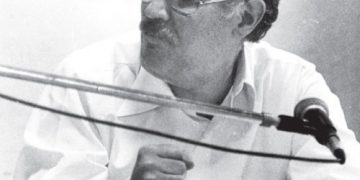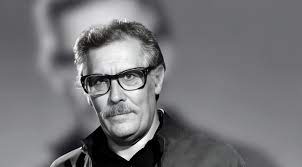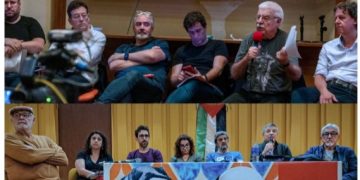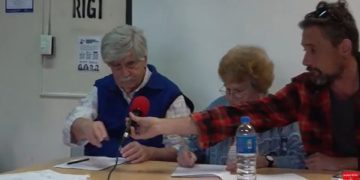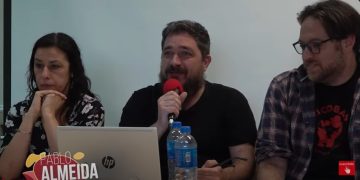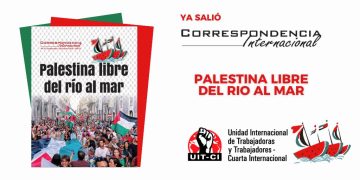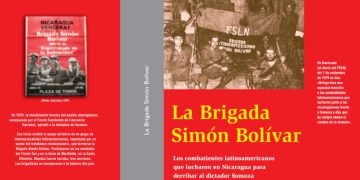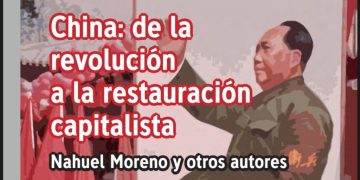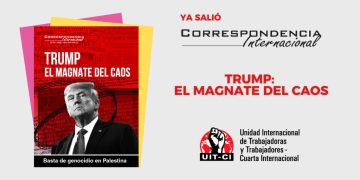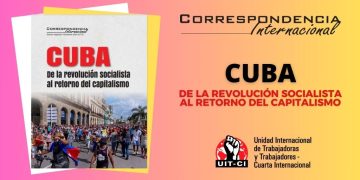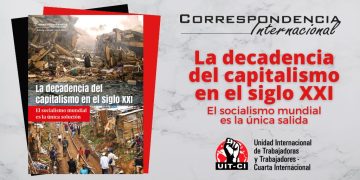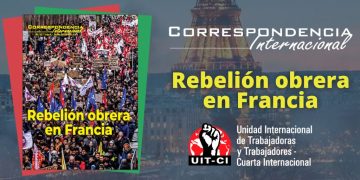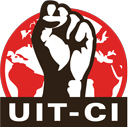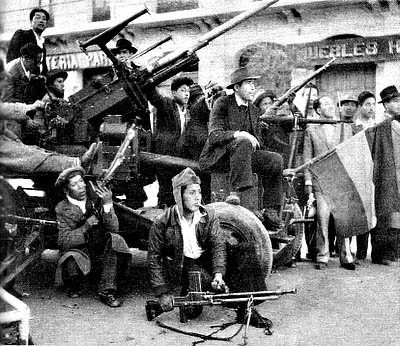 By Miguel Sorans
By Miguel Sorans
One hundred years have gone by and a similar victory has not been repeated. What is the cause? Is the struggle for workers’ and popular power no longer valid? Is it utopian to fight for workers’ governments and socialism? The problem is not the lack of revolutions or struggles. But the subsistence of the reformist apparatuses and the non-overcoming of the crisis of revolutionary leadership.
Without a doubt, this is the crucial debate on the world left and beyond. And it has intensified since the 1990s, after the fall of the Berlin Wall and the dissolution of the former URRS. Precisely imperialism and its spokesmen have used the fall of the false socialism of the Stalinist apparatus to place an equal sign with the «end of socialism» and the triumph of capitalism. The confusion created in the conscience of millions favoured the discourse of the world left reformist leaders to raise various slogans as the «struggle for what is possible». However, there will be no progress or substantive changes for the workers and the popular sectors without victories of new socialist revolutions.
Utopia or historical necessity?
Both, the bosses’ politicians, and the traditional reformist left or the neo-reformists enrolled in the Chavista, «national and popular» currents, or the European variants of «new left» as Podemos accuse us of «utopians», of defending «old stuff» or of being «ultra-sectarian». And that the time has come for the «renewal» of programs and the left and its policies. Hence, the message of «the possible» and to change or update the slogans.
Experience has shown that all «renewal» and «realist» projects of Marxism and the left have ended in a resounding failure for the workers, youth, women and the impoverished masses. Let’s see where the «Socialism of the Twenty-first Century» of Chavismo, the social model of Lula-Dilma-PT in Brazil or Syriza in Greece is. Promising what was «possible» and «realistic» they all ended up agreeing with the multinationals, paying fraudulent debts and starving their peoples with adjustments and social cuts.
The only «realistic» way to achieve a real change in the lives of the masses is the victory of a socialist revolution and that a workers’ government with workers’ and people’s democracy take over. We have never said that it is easy, but it is the only change of substance as historical experience has shown. Only socialist measures, the expropriation of the bourgeoisie and the multinationals and the planning of state ownership of the economy from a new state governed by the workers, can bring qualitative social achievements. Even national and bureaucratic socialist planning proved superior to capitalism, as experienced, for example, in the early years of the revolutions of Cuba or China.
There were triumphant revolutions but a new revolution of «October» was not repeated
For 100 years it has been shown that there is no possibility of fundamental changes by the reformist path. Only the social revolutions have caused changes. During the twentieth century and this early part of the twenty-first century, there have been great revolutions, many triumphant, that overthrew genocidal dictatorships or liberated peoples from their colonial situation. But none of these revolutions became a new socialist revolution like that of 1917. The experience of the Russian revolution remains an exception.
The Russian revolution was characterized by two things: (1) that revolutionary organizations of workers’ and masses’ power, such as the Soviets, emerged; and (2) the most important, the existence of a revolutionary party, such as the Bolshevik party of Lenin, of such influence that could lead the mass mobilization to seize power and initiate socialist changes with democracy for the workers and peasants. Without these two conditions, and especially without a revolutionary party leading the masses, there is no new October revolution. And, unfortunately, this is what it did not repeat again.
It is not that revolutions were lacking in these 100 years. There were many revolutions, triumphant and defeated. But none had at its head a party like the party of Lenin and Trotsky. All of them were led by reformist, bureaucratic parties and leaderships and traitorous of the socialist revolution. Even two great revolutions, such as the Chinese (1949) and Cuban (1959), succeeded in expropriating the bourgeoisie and broke with imperialism, but they did not have the leading role of the workers’ organisations and were led by bureaucratic leaders such as the Chinese CP or Castroism. This led to the emergence of bureaucratic «workers’ states», where their leaders froze the revolution and ended up making pacts with imperialism culminating in the restoration of capitalism.
The key to the non-repetition a new «October» was not the lack of heroism and capacity for action of the masses but the lack of a revolutionary leadership.
The victory of Stalinism was a catastrophe
In all the revolutionary processes mentioned and in so many other revolutions that have taken place in these 100 years, a revolutionary alternative of the weight and the characteristics of what was the Bolshevik party of Lenin in 1917 was lacking.
Trotsky said that the «crisis of mankind is the crisis of revolutionary leadership». The foundation of the Fourth International in 1938 by Trotsky had the goal of preserving revolutionary Marxism, its program, and by this way rebuilding revolutionary parties that would confront the counter-revolutionary social-democratic and Stalinist apparatuses.
Why is this crisis of leadership not yet overcome? Why have not strong revolutionary parties with mass influences in the style of the Bolshevik party emerged?
The central cause of all this has an explanation that we cannot tire of repeating: Stalinism triumphed over the revolutionaries since the mid-1920s and all this meant a catastrophe for the world workers’ movement.
That victory of Stalin, which endured after World War II, caused a huge setback in the consciousness of millions that, in different ways, reaches our days. Moreno called it «syphilis of the workers’ movement». Stalinism distorted all Marxism and the teachings of the October Revolution. It changed and distorted even the words. The word revolution became «revolution by stages», that is, conciliation and pacts with «progressive» bourgeois sectors. The party became a bureaucratic «single party» that could expel all those who opposed the «communist discipline». Socialism became a society dictatorially controlled by a bureaucratic caste full of privileges over most of its peoples.
The drama was amplified when after the Second World War Stalinism was strengthened and became of masses in the world. Millions believed in the figure of Stalin. The defeat of Nazism and the entry of the Red Army into Berlin in 1945 caused millions to attribute this to the «socialist» virtues of Stalin and the Communist Party of the USSR.
Trotsky was betting that the fall of Nazism in the hands of the workers and the Soviet people would end the Stalinist bureaucracy. Making a parallel with what happened with Social Democracy after the first war. But it was not so. On the contrary, Stalin and the USSR bureaucracy capitalised on the immense victory that meant Hitler’s defeat. Communist parties became of masses, especially in Europe. In this way, they surrendered the revolution in France, Italy, and Greece and agreed to rebuild imperialist capitalism in Europe in the postwar period.
This trust in the Stalinist apparatus meant an extraordinary setback in the consciousness of the masses. Millions believed that Stalin was a revolutionary, when in fact he was a traitor, executioner of the revolution. Millions of workers took to the streets of Paris and Rome with posters of Stalin. French workers followed the French CP’s slogan of «producing first» to stop the wave of strikes and to eliminate the revolutionary mobilisation of the French workers’ movement, which was armed and could have seized power, and the Italian as well. The Italian CP came to have nine million members, being the largest communist party outside the USSR and China. Millions of Italian communist workers trusted on the line of co-ruling with Christian Democracy and the rebuilding of bourgeois Italy. Stalinism or Moscow’s communism was transformed into a mass movement. Much of the intelligentsia and progressive artists became sympathisers of Stalin and the CPs. Even Diego Rivera and Frida Kahlo, who had sympathised with Trotskyism, turned to Stalinism.
Another tremendous victory of Stalin and his apparatuses is that they erased Trotsky from the history of the first years of the USSR, turned him into a «counter-revolutionary» and assassinated him in 1940. Millions of communist militants were educated in the conviction that the Trotskyists were divisive agents of the enemy.
After Stalin’s death in 1953, the «de-Stalinization» that Nikita Khrushchev led from 1956 was only a whitewash in face of the crisis the Stalinist apparatus and the figure of Stalin already had, manifested in the workers’ uprising in Berlin of 1953. But the policies of «peaceful coexistence» with imperialism, the revolution by stages, and the distortion of Marxism continued.
Such was the pressure of Stalinism and the confusion it created, that even sectors of Trotskyism capitulated. The Fourth International was very weak, with some thousands of militants in different countries. Its leadership, led by «Pabloism», a name given to the current led by Michel Pablo and Ernest Mandel, among others, analysed at the beginning of the 1950s that the third world war was coming and that the communist parties, forced to defend the USSR, would become revolutionaries, and they decided that the Trotskyists would make entryism into them. This lasted 20 years. This capitulation to Stalinism caused Trotskyism to disappear from Europe for many years. Only in 1968, with the French May, the Mandelists broke with the CP and founded the Revolutionary Communist League (LCR). This Mandelist sector, opportunist and revisionist, yielded to the great pressures of the powerful communist parties and the bourgeois nationalist movements. That is why Trotskyism lost the great opportunity of the Bolivian revolution of 1952, which could have been a new October and would have meant a qualitative change for the reconstruction of the Fourth International and especially in a continent of revolutions like Latin America (see box). Revisionism in our ranks was a very destructive factor.
The impact of the Chinese and Cuban revolutions and the guerrilla factor further isolated the revolutionaries
The victories of the Chinese and Cuban revolutions, with their leaders Mao and Fidel Castro, impacted the masses and made thousands of vanguard elements in the world become Maoists, Castroists and guerrillas. These movements channelled in the 1960s and 1970s the crisis of discredit of the Moscow apparatus. Mao’s leadership in China, although they declared themselves Stalinists, broke with Moscow in the early 1960s. They appeared as those who wanted to push the international revolution via the «protracted people’s war». Over time it became clear that the Maoist leadership, being Stalinist, also advised unity with «national bourgeois», such as Peronism in Argentina. And they betrayed the Indonesian revolution in 1965 by their pact with the bourgeois Sukarno. In Latin America, the impact of Cuba was absolute. The guerrilla commanders were not the «general secretaries» of the Kremlin apparatus, but people who risked their lives for a revolution. In this way, it can be said that the Maoist and Cuban guerrillas cushioned or channelled the crisis of the Soviet bureaucracy and its satellite communist parties. Trotskyism was once more isolated. Maoism and Castroism opposed, in a first stage, the guerrilla method to the development of workers’ and popular mobilisation and the formation of workers’ party with a revolutionary program. The Cuban leadership, with the exception of Che Guevara, quickly capitulated to the Moscow bureaucracy and went along with their policies of «peaceful coexistence» with imperialism. Fidel Castro stopped supporting revolutions and agreed with the regional bourgeois governments. But he did so from his authority as «commander» of a revolution; encouraging confusion in thousands and thousands of fighters. So when the 1979 Nicaraguan revolution took place, Castro advised the Sandinistas to «not make a new Cuba». A great betrayal, which the Morenist Trotskyists denounced, but was not seen by thousands and thousands of fighters who continued to blindly trust Fidel.
Nahuel Moreno pointed to this relationship between the backwardness of the mass consciousness and the existence of counter-revolutionary apparatuses: «Nearly all revolutions arise when the deepest objective needs of the mass movement come to an intolerable situation. But in relation to this objective situation leading to the revolution, their level of consciousness […] keeps lagging. Despite this lag, revolutions happen. […] The low level of consciousness of the worker’s movement, even during the revolution, allows the counter-revolutionary apparatuses and the petty bourgeois currents (reformist by program and conception) to connect with it and lead it during a stage» (Thesis XV, The Transitional Program Today). In this context, despite the great revolutions of the twentieth century, the crisis of the apparatus did not stop burst and the crisis of revolutionary leadership could not be overcome.
Causes of a crisis that lingers after the fall of the Berlin Wall
Finally, in 1989, Trotsky’s forecasts, continued after the Second World War by Nahuel Moreno, were fulfilled — that the counter-revolutionary apparatus with head in Moscow was going to explode in a tremendous crisis and that it could be knocked over with the mobilisation. The fall of the Berlin Wall symbolised the fall of the communist dictatorial regime of East Germany, the result of a revolutionary mobilisation. This was followed by the Romanian insurrection against Ceausescu and finally the dissolution of the former USSR, in 1991, amidst large mobilisations. The destruction of the Stalinist apparatus by mobilisation was an enormous victory of the masses. But it was a victory with many contradictions that did not allow overcoming the crisis of revolutionary leadership. The first is that these mobilisations, without revolutionary leadership, could not stop the ongoing process of capitalist restoration. Returning to capitalism meant a social counter-revolution. Seventy years of repression made it impossible to develop the formation in those countries of a Trotskyist revolutionary party that could take the leadership of the process. A huge political vacuum was generated that was quickly occupied by restorative bourgeois forces like Yeltsin and later Putin.
There was a period of great confusion in the consciousness of the masses in the world. The imperialist campaign that «socialism had failed» and that the struggle for this «utopia» had already ended penetrated the consciousness of the masses.
The fall of the Stalinist apparatus could not automatically give a new revolutionary leadership. In the twenty-first century, it has to be noted that there is an unexpected prolongation of the crisis of revolutionary leadership. The prognosis of our Morenist current that the triumph of a political revolution in the former URRS and the revolutionary fall of the Stalinist counter-revolutionary apparatus could give way to the emergence of revolutionary left or revolutionary centrist currents that fed the construction of new revolutionary parties did not happen. These currents of the revolutionary left, for now, have not been occurred. This is a fact.
But the positive aspect of the fall of the Stalinist apparatus is given in that it opened a process of world political revolution; a process of rebellion of the ranks against its political or union leaders. This is a global phenomenon today. And it takes place in almost all countries in various ways. It is manifested in a widespread disbelief in the old traditional bourgeois parties, bipartisanship is broken, situations of political instability are created, the punishment vote grows, abstention and, in the most positive way, strikes and popular mobilisations against the governments that apply the austerity measures and social cuts. This process is what feeds the fight to overcome the crisis of revolutionary leadership.
In this process of change, neo-reformists currents recycled themselves and managed to channel circumstantially those breaks. In fact, they postulated themselves as the continuators with «criticism» of the Soviet apparatus, but with modernised forms such as «Twenty-first Century Socialism» or the «Bolivarian Revolution». Chavez always quoted Lenin and sometimes even Trotsky. Thus emerged Chavismo, closely linked to the Cuban leadership, Evo Morales, in Bolivia, Lula and the PT in Brazil, or similar variants in Europe as Syriza or Podemos. It is a neo-reformism or neo-Stalinism that holds the same counter-revolutionary conceptions of the Mensheviks in 1917, of conciliation and pact with the bourgeoisie, the revolution in stages, its anti-worker policies and that have already begun to enter into crisis. But it creates new confusions by fouling socialism. Thousands upon thousands are beginning to wonder if these are not «other failures of socialism».
These new neo-reformists apparatuses in government have entered into their final crisis — with more or less confusion, the masses and their vanguard will make their experience. It is part of the general process of anti-bureaucratic political revolution, of rebellion from below.
The struggle to build new revolutionary parties is the challenge of the twenty-first century
We continue seeing in the facts the need for new Octobers and therefore, we propose the strategic task of constructing revolutionary parties, under the model of the Bolsheviks, and from an internationalist perspective. The same vision bequeathed us by Lenin and Trotsky. In this sense we continue on the path of rebuilding the Fourth International, seeking unity with other revolutionary forces. It is not a moral imperative. We are not a church either. We continue to see that there is no alternative for the exploited masses. It takes more or less time. But the fight is the same.
That is why we continue to fight all those who yield to the confusion in the consciousness and the pressures of the «what is possible» fashions. Or to the style of Sub-Commander Marcos of putting everything in doubt and to «walk asking». Or trying to build parties or broad «anti-capitalist» movements, on the Internet, with whitewashed programs and without words like «expropriation», «nationalization», «bourgeois party», «democratic centralism» or «workers’ government», to replace them by «mixed economy», «social property», «political caste», «build popular power from below», or «popular governments in dispute.»
This is why we have been fighting the new reformist variants like the false «Socialism of the Twenty-first Century» or the new deceptions of variants of «new left» as Syriza or Podemos.
The task remains the fight to overcome the crisis of revolutionary leadership in each country and in the world. That is, to build revolutionary parties based on a program of struggle for the power of workers and the triumph of a new revolution of October.
The crisis of reformist and bureaucratic political apparatuses continues. The rebellion of the bases against governments and their political leaders grows. This will open up new opportunities to continue fighting the leadership. We must be open to the new political and union phenomena that may arise on the left, so that the revolutionaries take part, without sectarianism and with all boldness, to build the revolutionary parties.











